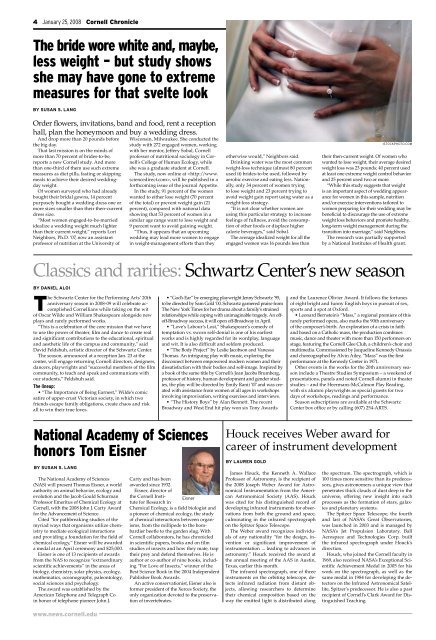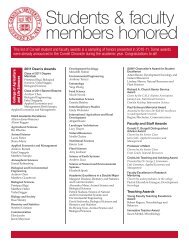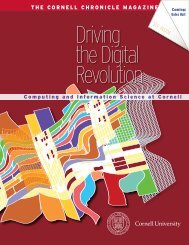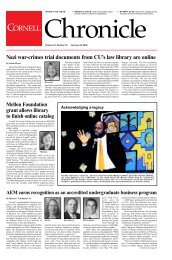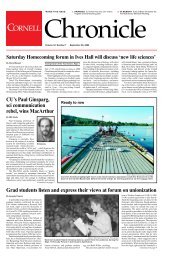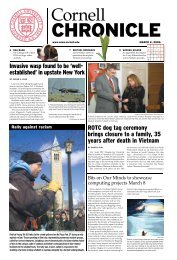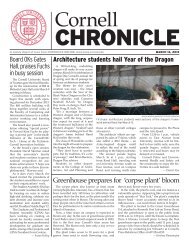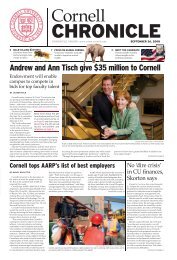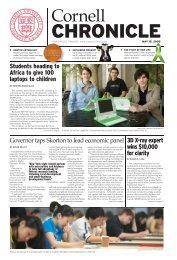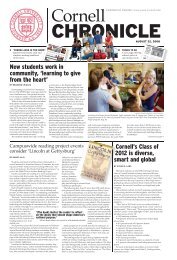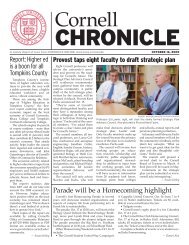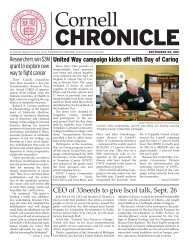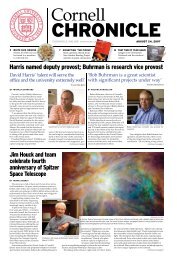continued from page 1 - Cornell University News Service
continued from page 1 - Cornell University News Service
continued from page 1 - Cornell University News Service
Create successful ePaper yourself
Turn your PDF publications into a flip-book with our unique Google optimized e-Paper software.
January 25, 2008 <strong>Cornell</strong> Chronicle<br />
The bride wore white and, maybe,<br />
less weight – but study shows<br />
she may have gone to extreme<br />
measures for that svelte look<br />
By SuSan S. Lang<br />
Order flowers, invitations, band and food, rent a reception<br />
hall, plan the honeymoon and buy a wedding dress.<br />
And drop more than 20 pounds before<br />
the big day.<br />
That last mission is on the minds of<br />
more than 70 percent of brides-to-be,<br />
reports a new <strong>Cornell</strong> study. And more<br />
than one-third of them use such extreme<br />
measures as diet pills, fasting or skipping<br />
meals to achieve their desired weddingday<br />
weight.<br />
Of women surveyed who had already<br />
bought their bridal gowns, 14 percent<br />
purposely bought a wedding dress one or<br />
more sizes smaller than their then-current<br />
dress size.<br />
“Most women engaged-to-be-married<br />
idealize a wedding weight much lighter<br />
than their current weight,” reports Lori<br />
Neighbors, Ph.D. ‘07, now an assistant<br />
professor of nutrition at the <strong>University</strong> of<br />
National Academy of Sciences<br />
honors Tom Eisner<br />
By SuSan S. Lang<br />
www.news.cornell.edu<br />
Wisconsin, Milwaukee. She conducted the<br />
study with 272 engaged women, working<br />
with her mentor, Jeffery Sobal, <strong>Cornell</strong><br />
professor of nutritional sociology in <strong>Cornell</strong>’s<br />
College of Human Ecology, while<br />
she was a graduate student at <strong>Cornell</strong>.<br />
The study, now online at , will be published in a<br />
forthcoming issue of the journal Appetite.<br />
In the study, 91 percent of the women<br />
wanted to either lose weight (70 percent<br />
of the total) or prevent weight gain (21<br />
percent), compared with national data<br />
showing that 53 percent of women in a<br />
similar age range want to lose weight and<br />
9 percent want to avoid gaining weight.<br />
“Thus, it appears that an upcoming<br />
wedding may lead more women to engage<br />
in weight-management efforts than they<br />
otherwise would,” Neighbors said.<br />
Drinking water was the most common<br />
weight-loss technique (almost 80 percent<br />
used it) brides-to-be used, followed by<br />
aerobic exercise and eating less. Nationally,<br />
only 34 percent of women trying<br />
to lose weight and 23 percent trying to<br />
avoid weight gain report using water as a<br />
weight-loss strategy.<br />
“It is not clear whether women are<br />
using this particular strategy to increase<br />
feelings of fullness, avoid the consumption<br />
of other foods or displace higher<br />
calorie beverages,” said Sobal.<br />
The average idealized weight for all the<br />
engaged women was 16 pounds less than<br />
istockphoto.com<br />
their then-current weight. Of women who<br />
wanted to lose weight, their average desired<br />
weight loss was 23 pounds; 40 percent used<br />
at least one extreme weight control behavior<br />
and 25 percent used two or more.<br />
“While this study suggests that weight<br />
is an important aspect of wedding appearance<br />
for women in this sample, nutrition<br />
and/or exercise interventions tailored to<br />
women preparing for their wedding may be<br />
beneficial to discourage the use of extreme<br />
weight loss behaviors and promote healthy,<br />
long-term weight management during the<br />
transition into marriage,” said Neighbors.<br />
The research was partially supported<br />
by a National Institutes of Health grant.<br />
Classics and rarities: Schwartz Center’s new season<br />
By DanieL aLoi<br />
The Schwartz Center for the Performing Arts’ 20th<br />
anniversary season in 2008-09 will celebrate accomplished<br />
<strong>Cornell</strong>ians while taking on the wit<br />
of Oscar Wilde and William Shakespeare alongside new<br />
plays and rarely performed works.<br />
“This is a celebration of the core mission that we have<br />
to use the power of theater, film and dance to create real<br />
and significant contributions to the educational, spiritual<br />
and aesthetic life of the campus and community,” said<br />
David Feldshuh, artistic director of the Schwartz Center.<br />
The season, announced at a reception Jan. 23 at the<br />
center, will engage returning <strong>Cornell</strong> directors, designers,<br />
dancers, playwrights and “successful members of the film<br />
community, to teach and speak and communicate with<br />
our students,” Feldshuh said.<br />
The lineup:<br />
• “The Importance of Being Earnest,” Wilde’s comic<br />
satire of upper-crust Victorian society, in which two<br />
friends escape family obligations, create chaos and risk<br />
all to win their true loves.<br />
The National Academy of Sciences<br />
(NAS) will present Thomas Eisner, a world<br />
authority on animal behavior, ecology and<br />
evolution and the Jacob Gould Schurman<br />
Professor Emeritus of Chemical Ecology at<br />
<strong>Cornell</strong>, with the 2008 John J. Carty Award<br />
for the Advancement of Science.<br />
Cited “for pathbreaking studies of the<br />
myriad ways that organisms utilize chemistry<br />
to mediate ecological interactions<br />
and providing a foundation for the field of<br />
chemical ecology,” Eisner will be awarded<br />
a medal at an April ceremony and $25,000.<br />
Eisner is one of 13 recipients of awards<br />
<strong>from</strong> the NAS to recognize “extraordinary<br />
scientific achievements” in the areas of<br />
biology, chemistry, solar physics, ecology,<br />
mathematics, oceanography, paleontology,<br />
social sciences and psychology.<br />
The award was established by the<br />
American Telephone and Telegraph Co.<br />
in honor of telephone pioneer John J.<br />
• “God’s Ear” by emerging playwright Jenny Schwartz ’95,<br />
to be directed by Sam Gold ’00. Schwartz garnered praise <strong>from</strong><br />
The New York Times for her drama about a family’s strained<br />
relationships while coping with unimaginable tragedy. An offoff-Broadway<br />
success, it will open off-Broadway in April.<br />
• “Love’s Labour’s Lost,” Shakespeare’s comedy of<br />
temptation vs. sworn self-denial is one of his earliest<br />
works and is highly regarded for its wordplay, language<br />
and wit. It is also difficult and seldom produced.<br />
• “The Body Project” by Leslie Jacobson and Vanessa<br />
Thomas. An intriguing play with music, exploring the<br />
disconnect between empowered modern women and their<br />
dissatisfaction with their bodies and self-image. Inspired by<br />
a book of the same title by <strong>Cornell</strong>’s Joan Jacobs Brumberg,<br />
professor of history, human development and gender studies,<br />
the play will be directed by Emily Ranii ‘07 and was created<br />
with assistance <strong>from</strong> women of all ages in workshops<br />
involving improvisation, writing exercises and interviews.<br />
• “The History Boys” by Alan Bennett. The recent<br />
Broadway and West End hit play won six Tony Awards<br />
Carty and has been<br />
awarded since 1932.<br />
Eisner, director of<br />
the <strong>Cornell</strong> Insti-<br />
Eisner<br />
tute for Research in<br />
Chemical Ecology, is a field biologist and<br />
a pioneer of chemical ecology, the study<br />
of chemical interactions between organisms,<br />
<strong>from</strong> the millipede to the bombardier<br />
beetle to the garden slug. With<br />
<strong>Cornell</strong> collaborators, he has chronicled<br />
in scientific papers, books and on film<br />
studies of insects and how they mate, trap<br />
their prey and defend themselves. He is<br />
author or co-author of nine books, including<br />
“For Love of Insects,” winner of the<br />
Best Science Book in the 2004 Independent<br />
Publisher Book Awards.<br />
An active conservationist, Eisner also is<br />
former president of the Xerces Society, the<br />
only organization devoted to the preservation<br />
of invertebrates.<br />
and the Laurence Olivier Award. It follows the fortunes<br />
of eight bright and funny English boys in pursuit of sex,<br />
sports and a spot at Oxford.<br />
• Leonard Bernstein’s “Mass,” a regional premiere of this<br />
rarely performed opera, also marks the 90th anniversary<br />
of the composer’s birth. An exploration of a crisis in faith<br />
and based on a Catholic mass, the production combines<br />
music, dance and theater with more than 150 performers on<br />
stage, featuring the <strong>Cornell</strong> Glee Club, a children’s choir and<br />
multimedia. Commissioned by Jacqueline Kennedy Onassis<br />
and choreographed by Alvin Ailey, “Mass” was the first<br />
performance at the Kennedy Center in 1971.<br />
Other events in the works for the 20th anniversary season<br />
include a Theatre Studies Symposium – a weekend of<br />
presentations, panels and noted <strong>Cornell</strong> alumni in theater<br />
studies – and the Heermans-McCalmon Play Reading,<br />
with six alumni playwrights as special guests for two<br />
days of workshops, readings and performance.<br />
Season subscriptions are available at the Schwartz<br />
Center box office or by calling (607) 254-ARTS.<br />
Houck receives Weber award for<br />
career of instrument development<br />
By Lauren goLD<br />
James Houck, the Kenneth A. Wallace<br />
Professor of Astronomy, is the recipient of<br />
the 2008 Joseph Weber Award for Astronomical<br />
Instrumentation <strong>from</strong> the American<br />
Astronomical Society (AAS). Houck<br />
was cited for his distinguished record of<br />
developing infrared instruments for observations<br />
<strong>from</strong> both the ground and space,<br />
culminating in the infrared spectrograph<br />
on the Spitzer Space Telescope.<br />
The Weber award recognizes individuals<br />
of any nationality “for the design, invention<br />
or significant improvement of<br />
instrumentation ... leading to advances in<br />
astronomy.” Houck received the award at<br />
the annual meeting of the AAS in Austin,<br />
Texas, earlier this month.<br />
The infrared spectrograph, one of three<br />
instruments on the orbiting telescope, detects<br />
infrared radiation <strong>from</strong> distant objects,<br />
allowing researchers to determine<br />
their chemical composition based on the<br />
way the emitted light is distributed along<br />
the spectrum. The spectrograph, which is<br />
100 times more sensitive than its predecessors,<br />
gives astronomers a unique view that<br />
penetrates thick clouds of dust deep in the<br />
universe, offering new insight into such<br />
processes as the formation of stars, galaxies<br />
and planetary systems.<br />
The Spitzer Space Telescope, the fourth<br />
and last of NASA’s Great Observatories,<br />
was launched in 2003 and is managed by<br />
NASA’s Jet Propulsion Laboratory. Ball<br />
Aerospace and Technologies Corp. built<br />
the infrared spectrograph under Houck’s<br />
direction.<br />
Houck, who joined the <strong>Cornell</strong> faculty in<br />
1969, also received NASA’s Exceptional Scientific<br />
Achievement Medal in 2005 for his<br />
work on the spectrograph, as well as the<br />
same medal in 1984 for developing the detectors<br />
on the Infrared Astronomical Satellite,<br />
Spitzer’s predecessor. He is also a past<br />
recipient of <strong>Cornell</strong>’s Clark Award for Distinguished<br />
Teaching.


